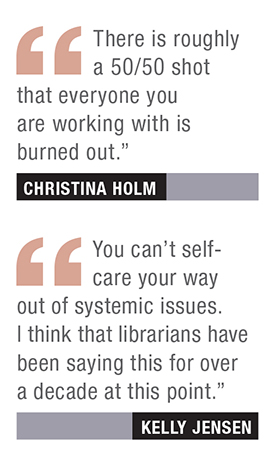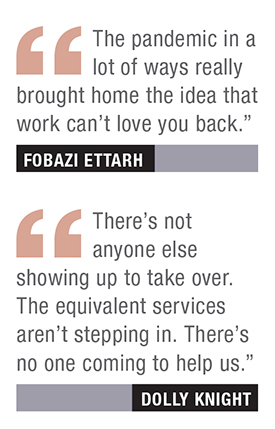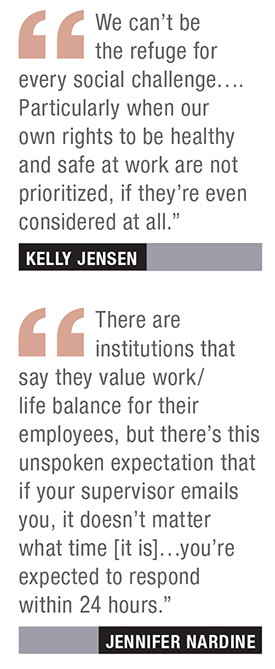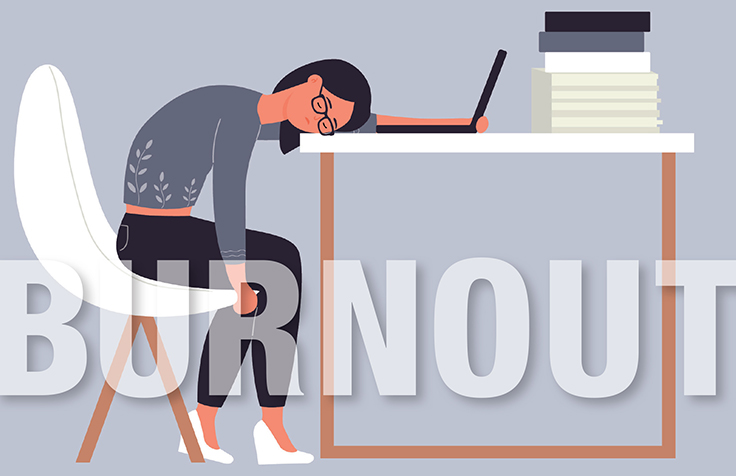Feeling the Burnout
Library workers are facing burnout in greater numbers and severity—and grappling with it as a systemic problem.
Library workers are facing burnout in greater numbers and severity—and grappling with it as a systemic problem
We are all exhausted. Burnout among library workers—as in many public-facing and service-oriented professions—has always existed. With the trials of the past two pandemic years, however, the issue has been pushed to the forefront and library employees are publicly discussing causes of burnout and potential solutions.
UNDERSTANDING BURNOUT
The term burnout describes a high level of stress and exhaustion, often linked to overwhelming professional pressures but spilling over into private life as well. People experiencing burnout describe themselves as depleted and drained, and may struggle to manifest enthusiasm for their work or for other activities. Beyond a lack of productivity at work, it can have health consequences for sufferers. Sarah Houghton, director of discovery and delivery for the California Digital Library, who has written and presented on the topic of burnout, describes symptoms as “exhaustion, disinterest in work…people being a lot twitchier emotionally, quicker to get angry, quicker to cry.” It may also play into library workers choosing to leave their jobs, if not the profession altogether: A recent MissionSquare Research Institute survey found that 52 percent of public sector workers are inclined to leave their jobs voluntarily, driven largely by burnout and compensation issues.
Burnout has been identified as an issue among staff at all library types, and impacts library workers regardless of their official title and duties. While specific burnout causes vary depending on the type of work and related stressors, many symptoms are the same. Professionals may experience “anxiety levels that way outscale what is appropriate for the situation, may be not sleeping well and coming in exhausted,” Houghton says, and may take an increased number of sick days.
“There is roughly a 50/50 shot that everyone you are working with is burned out,” says Christina Holm, librarian and associate professor of library science at Kennesaw State University, GA, who has studied and published on this issue, including editing a forthcoming book on librarian burnout. While the pandemic has increased stress for many, no single factor created the current burnout issues for librarians. Holm notes stressors such as “precarity in work circumstances” and “depressed and stagnating wages,” particularly at institutions where wages start low and do not see regularly stepped increases.
 While burnout is common throughout the profession, Holm’s research indicates that there are higher incidences of burnout among female respondents, particularly those between ages 35 and 44. Librarianship has a long history as a predominantly female profession, and “I think that plays out in the way that librarians are treated,” says Holm, who notes the presence of “gendered workplace expectations and social interactions.”
While burnout is common throughout the profession, Holm’s research indicates that there are higher incidences of burnout among female respondents, particularly those between ages 35 and 44. Librarianship has a long history as a predominantly female profession, and “I think that plays out in the way that librarians are treated,” says Holm, who notes the presence of “gendered workplace expectations and social interactions.”
Moreover, “I suspect that female-identified librarians are working a second shift,” Holm tells LJ, referring to domestic labor that traditionally falls disproportionately on women. This is all the more relevant at a time when the plight of working parents has often made headlines, with pandemic school closures, concerns about children who are too young for vaccines or boosters returning to classrooms and day cares, and a lack of paid leave increasing the pressure.
The pandemic may also have revealed the limitations of library workers’ sense of vocation and willingness to push themselves to the brink, as many were expected to work in person even when they did not feel safe doing so. “The pandemic in a lot of ways really brought home the idea that work can’t love you back,” says Fobazi Ettarh, a consultant and scholar who has worked as a school and academic librarian. “You have to take care of your own well-being, because the institution will always keep moving, regardless of whether or not you’re there.”
ALL THINGS TO ALL PEOPLE
Houghton observed burnout during her years working in public libraries, exacerbated by the immense expectations that patrons place on library services and staff. “Failing or lack of social infrastructure or social services in our communities means everyone expects everything from the library…it just seems to [grow],” she says. There is “pure exhaustion—not from being overscheduled, [but] from the sheer amount of diverse emotional labor that staff are being asked to perform day after day, without training or education in the areas that were new to them.”
“There’s this perception that libraries should do everything,” says Kelly Jensen, who worked in public libraries and is now an editor at BookRiot. For years, libraries have been a refuge and support for their communities, and even before the pandemic, library workers expressed concern about the expectation that they do work better suited to trained social workers in addition to traditional library work. Staff who were drawn to the profession because of a desire to help others may hesitate to speak up when they are overwhelmed by demands. “Part of the challenge is, you don’t want to say anything…because you don’t want to worry about how that will reflect on your employer, if you express any opinion aside from ‘we’re doing the best thing in the world.’ Yeah, you are, but you’re also a human in the world,” says Jensen.
In public libraries, the expectation that library staff must deal with their community’s major social challenges is a significant burnout trigger. Librarians may be asked to handle addiction and overdoses, including by learning to dispense Naloxone. According to Dolly Knight, former senior city librarian for the County of Ventura, CA, “There’s this mission creep. A lot of people in the profession do enjoy being of service and want to help.” When faced with the needs of unhoused community members, for example, or individuals experiencing addiction, she says, “They want to find a way to contribute. But the thing that makes it more difficult is if it’s something you’re not trained for and not getting support for.”
Multiple librarians mentioned to LJ that some public libraries are designated distribution sites for rapid COVID tests, putting librarians without public health training directly in contact with patrons who may be ill or in need of medical advice. Others noted recent discussion of the Seattle Public Library, which shut down during a snow emergency that made it dangerous for staff to travel in to work, rather than remaining open as a warming shelter. There are gaps in public services that libraries are expected to fill for their communities, but library workers may not have the capacity to do so. The problem, Knight tells LJ, is that libraries are left to shoulder these responsibilities without backup. “There’s not anyone else showing up to take over. The equivalent services aren’t stepping in,” she says. “There’s no one coming to help us.”
“One of the biggest system-wide problems, when it comes to librarianship, is job creep,” says Ettarh. Communities and institutions believe, and library workers themselves also often feel, that they can “be everything for everyone. Part of it is a reaction to the idea that libraries are obsolete, now that we have Google and the internet…the idea that we have to continue to prove our value. So if we do everything for everyone, there’s no way our budgets can be slashed, or they can try and take over our spaces. But what that leads to is an inordinate amount of work that cannot possibly be done within a 40-hour work week.”
The expectation to do more with less translates, at many libraries, to inadequate staffing for the volume of responsibilities placed on the library team. Mike Martinez Jr., director of the Law Library at St. Mary’s University School of Law, San Antonio, TX, is one of two librarians on staff for a student population of over 600. “The services are on a wing and a prayer.... My burnout comes from the fact that I cannot do everything,” he says. “We are so adamant about being a service-oriented group,” Martinez says of librarians who push themselves to reach their communities and deliver the services they think they “should” be providing. “I am figuring out that I don’t have the bandwidth to be everything to everyone.”
The pandemic, of course, has exacerbated the problem, as many librarians faced expectations to provide the same level of service remotely as they did in person despite personal, technical, and budget challenges and learning curves, and, later, to return to in-person work despite the risk to their own health. “The pandemic [is] a lot of business as usual with a side dose of potential death,” says Holm. “I don’t think the pandemic materially changed very much of how librarians operate under a persistent system of scarcity.” At a certain point, it can all simply become too much. “We can’t be the refuge for every social challenge,” says Jensen. “Particularly when our own rights to be healthy and safe at work are not prioritized, if they’re even considered at all.”
VOCATION AND OVERWORK
Librarians “identify with a high sense of vocation,” rather than seeing this work as merely an occupation, and with that, according to Ginny Moran, instruction and research librarian at Macalester College, St. Paul, MN, “comes this sense of asceticism…making do with less.” With institutions continually cutting budgets without actually reducing their expectations of what library workers can accomplish, those who are committed to service and to their profession will continue pushing themselves to the point of burnout.
 Ettarh coined the term vocational awe to describe this phenomenon in librarianship and other service professions. According to Ettarh, her awareness of this issue emerged during her research. “The ways in which people of color and other marginalized groups were being further marginalized by the fact that they seemingly couldn’t speak on anything wrong within librarianship or around libraries. There seemed to be real pushback anytime anyone brought up any of the problems around libraries. The reaction would be, ‘But libraries do so much good, they’re the last non-capitalist thing.’ ” She questions, “Why is it that we use the language of the sacred when we talk about libraries? Why is it that when anyone brings up issues that there is such violent defensive pushback?”
Ettarh coined the term vocational awe to describe this phenomenon in librarianship and other service professions. According to Ettarh, her awareness of this issue emerged during her research. “The ways in which people of color and other marginalized groups were being further marginalized by the fact that they seemingly couldn’t speak on anything wrong within librarianship or around libraries. There seemed to be real pushback anytime anyone brought up any of the problems around libraries. The reaction would be, ‘But libraries do so much good, they’re the last non-capitalist thing.’ ” She questions, “Why is it that we use the language of the sacred when we talk about libraries? Why is it that when anyone brings up issues that there is such violent defensive pushback?”
According to Jennifer Nardine, teaching and learning engagement librarian at Virginia Tech, Blacksburg, VA, who has studied the impact of burnout on academic liaison librarians, librarians told her that “their personal values tracked very well with the stated institutional values of the places they worked” and that this led them to continue in a challenging work environment. There is “a disconnect between the stated values and what goes on day to day” at some institutions, Nardine observes. “There are institutions that say they value work/life balance for their employees, but there’s this unspoken expectation that if your supervisor emails you, it doesn’t matter what time [it is]…you’re expected to respond within 24 hours.” Holding boundaries can prove challenging, if not impossible.
Once enthusiastic professionals, library staff facing burnout may question their commitment to their work—or may leave librarianship entirely. “These people who were so passionate about the job and what they were doing, it’s hard for them to maintain that, when they don’t feel like they are being supported,” says Jensen. “The biggest thing is feeling like they are being ignored, or not listened to, or that their concerns about working in a public space are really being minimized.”
A lack of autonomy in the workplace can cause or exacerbate burnout—something library workers can experience when faced with limited resources and demanding supervisors and patrons, as well as frequently hierarchical library staffing. Both Nardine and Holm, in their studies of burnout among academic librarians, have cited a lack of control over their work as factors in professional burnout. In addition, in spite of the skills and expertise that they bring to their work, as service professionals they may not receive respect from patrons and colleagues. In an academic context, “some of the interactions…between librarians and other faculty can be very disheartening,” says Nardine, “because librarians don’t get the respect that other professors on campus do.” And, of course, in the public library context, the pandemic has brought to light angry patron responses to library staffers put in the position of enforcing mask and vaccine mandates akin to those faced by restaurant workers, nurses, and flight attendants.
NO ROOM FOR REST
The absenteeism that is a symptom of burnout, as well as librarians simply leaving the profession, combines with understaffing to create a stressful environment. Staff “are tired, they’re exhausted, they just need that time. It’s tough with a lot of libraries that are staffed in such a way that makes it hard to fill in, which increases burnout,” says Knight. “If someone does call out, they take a day for themselves, and then their manager makes them feel bad. People put that burden on themselves, and feel they can’t call out.”
Setting boundaries and self-advocacy can be challenging in the face of vocational awe and immense expectations, Ettarh tells LJ. “It can be really hard to say, ‘I would like to take my full lunch break,’ or ‘I would like to actually go on vacation,’ or use sick days. There is no support for those who want to slow down, who want to take a breath. It’s always innovate, innovate, innovate, it’s always serve, serve, serve, do more with less. At every turn we as library workers are being asked to do more and not given any institutional support or personal support to handle all of it.”
Katarina Daniels, assistant librarian at the Law Library at McGill University, Montreal, tells LJ that “the only reason I didn’t actually [take time off for] burnout was because I couldn’t do that to the students.... Similarly, I wanted to help the professors who were also scrambling to adapt to remote teaching” during COVID-related shutdowns. This sense of obligation pushed her to continue her work as part of an “incredibly understaffed” team, coping with burnout symptoms such as “having no energy to interact with my toddler…saying ‘no’ to events I would ordinarily attend (including ones that I know would help advance my career), anxiety attacks…[and] doomsday scrolling social media.” While librarians believe in the value of the services that they deliver to their patrons, high expectations and limited resources are pushing professionals to burnout.
HOW DO WE FIX THIS?
“One hundred percent of the responsibility [for combating burnout] sits with the employer,” says Houghton. For public-facing staff, employers should not be “allowing a situation to exist that is full of harassment or of people working out of their job classifications,” she notes. Employers must support staff with adequate training and by creating a work environment where patrons will not mistreat them—particularly where there is pushback against masking or proof of vaccine mandates. This requires meaningful changes, and not just what Houghton describes as “self-care theater.”
 While suggestions for “self-care” from institutions and supervisors who are themselves dealing with a lack of resources and support may be well intentioned, library workers consistently tell LJ that it falls short of combating the intense burnout they are seeing. “You can’t self-care your way out of systemic issues. I think that librarians have been saying this for over a decade at this point,” says Jensen. She references one librarian who was told at a recent staff meeting “that to solve their problems they should create vision boards. Being told that the solution to not having the money, all these true problems, is to create a vision board and manifest it. What is this magical thinking?”
While suggestions for “self-care” from institutions and supervisors who are themselves dealing with a lack of resources and support may be well intentioned, library workers consistently tell LJ that it falls short of combating the intense burnout they are seeing. “You can’t self-care your way out of systemic issues. I think that librarians have been saying this for over a decade at this point,” says Jensen. She references one librarian who was told at a recent staff meeting “that to solve their problems they should create vision boards. Being told that the solution to not having the money, all these true problems, is to create a vision board and manifest it. What is this magical thinking?”
Veronda Pitchford, assistant director at the California library consortium Califa Group, is working on educational materials and events around the issue of library staff trauma. “We want to hold space for this issue and look at how it can be addressed by an individual, an organization, and an industry,” she says. She also tells LJ that it is important “to move the conversation past self-care. It’s a very nuanced, individual, and complex response [to address trauma]. That depends on the person, their lived experience.”
In many instances, the pandemic has taught library employers about the power of flexibility in work hours and location—and this may provide a tool to combat burnout. “Management really has to take a look at what they’re saying and what they’re doing” when it comes to valuing work/life balance, says Nardine. Supervisors and administrators should “consistently allow people to have a flexible schedule if that’s functionally possible,” which can promote autonomy and combat overwork, she says.
Self-advocacy can go only so far in combating burnout, and can in fact create a culture where individuals are made to feel responsible for their own burnout. “At the end of the day, knowing what we do about race and gendered workplace interactions—essentially that, no matter what, some individuals will have a greater ability to advocate for themselves, based entirely on factors outside their control—I don’t think it’s kind to place the impetus for avoiding burnout on the individual,” says Holm. She recommends creating work cultures that give employees more autonomy, and avoiding micromanagement. She also notes the importance of supporting workers who face physical or mental health challenges, and identifying workplace practices that promote well-being—“things like not requiring facetime in the office, or having truly flexible mental health days.”
As a library director, Houghton found it “extremely frustrating” to realize how little she could do to help staff members experiencing burnout. “I felt like most library administrations and most parent organizations, whether it was a municipality or a university…[offered] little to no acknowledgment that this was pretty much a profession-wide phenomenon.” Addressing burnout requires moving away from “toxic positivity” and a refusal to acknowledge some of the negative aspects of librarianship. Talia Nadir, research and instruction librarian at the University of St. Thomas, MN, who has published and presented on this and related topics along with Moran, notes the harm that can come from unrelenting “service with a smile.” “We should not go back to normal. Things can change in a way that we can reflect,” says Nadir.
For librarians experiencing mission creep, in particular public librarians overwhelmed by providing community services, valuable systemic change could come in the form of enhanced support and social services beyond the library. “Where we ourselves don’t really have capacity, for support to come in…that’s something I would love to see more of. Things we can refer people to,” says Knight, noting that some libraries fill this need by having social workers on-site. “That’s the piece that’s missing, where we’re the frontline.” However, many of these services do not exist in most places, and often those providing these services are themselves facing burnout and lacking resources.
Systemic change will need to empower library professionals to advocate for themselves and to set meaningful boundaries at work. “Awareness is a good start, but I would hope that it wouldn’t end there,” says Ettarh. “The next step would be helping people create coalitions, create basically unions or de facto unions…to really advocate for themselves and their fellow workers. So that slowly but surely the idea that you would work through lunch all the time, and not take vacation ever, is seen as the weird rather than the normal.”
Pitchford emphasizes “the complexity and the need for a holistic approach to the issue, the respect and compassion and grace that need to come along with it, along with continuing this conversation and talking about systemic ways to create safe space for us to do these essential roles.” Open and honest discussions about burnout, without downplaying the harm it does or assuming it is an unavoidable fact of this work, may be the first step in lessening this burden on librarians. “Nursing has this idea that you should practice trauma-informed care—being aware that your work may predispose you to burnout,” says Holm, suggesting that librarians can do the same (for more suggestions taken from nursing workplace culture, see “How-Tos at LibLearnX 2022 Tackle Cultural Change”).
The more librarians talk about what they are experiencing, the easier it will be to spot the signs of burnout and to help. There is certainly no easy way out; burnout among librarians is the result of a host of systemic issues. No one person or institution will transform things overnight, but talking openly about the issue can be a start. “We are not going to have an answer. There will not be a magic pill at the end of this that we can all take,” says Pitchford. Nevertheless, “we have to keep pushing these conversations.”
Jennifer A. Dixon is Collection Management Librarian, Maloney Library, Fordham University School of Law, NY.
RELATED
ALREADY A SUBSCRIBER? LOG IN
We are currently offering this content for free. Sign up now to activate your personal profile, where you can save articles for future viewing










Add Comment :-
Comment Policy:
Comment should not be empty !!!